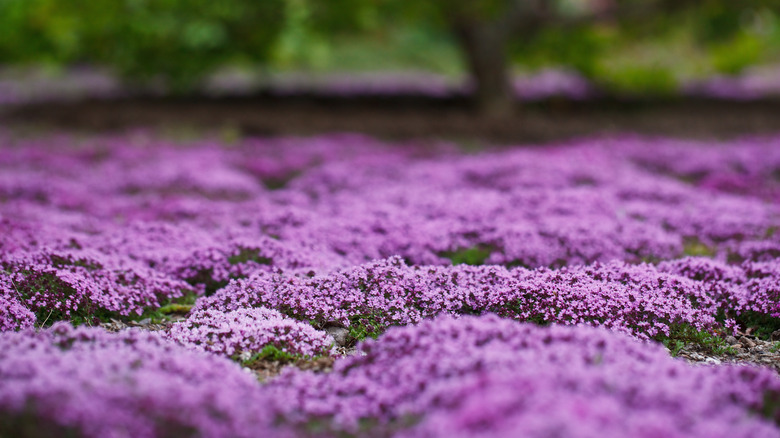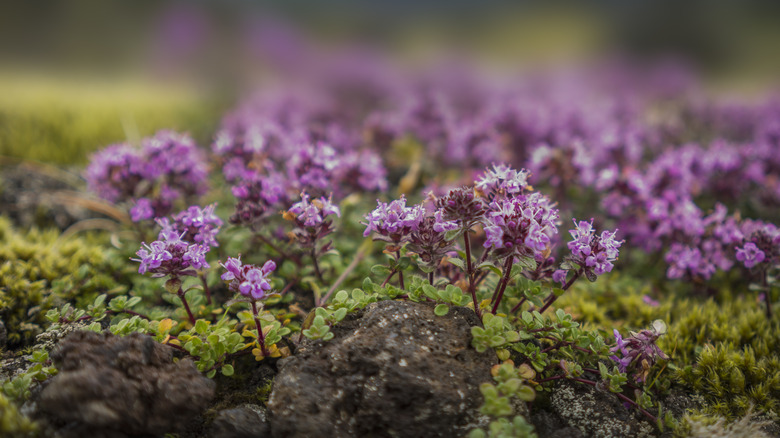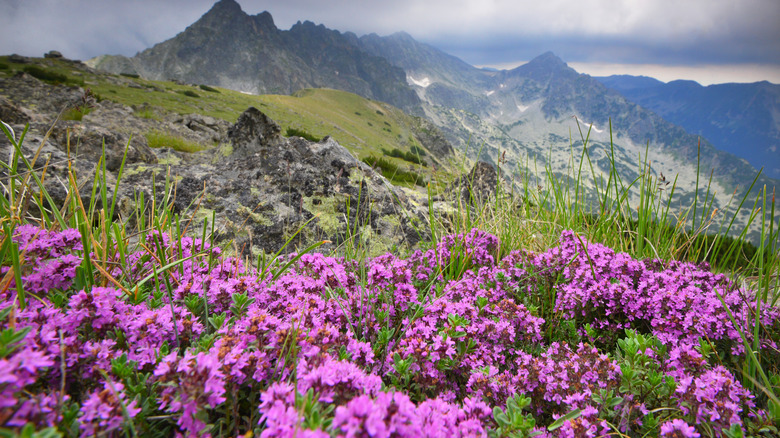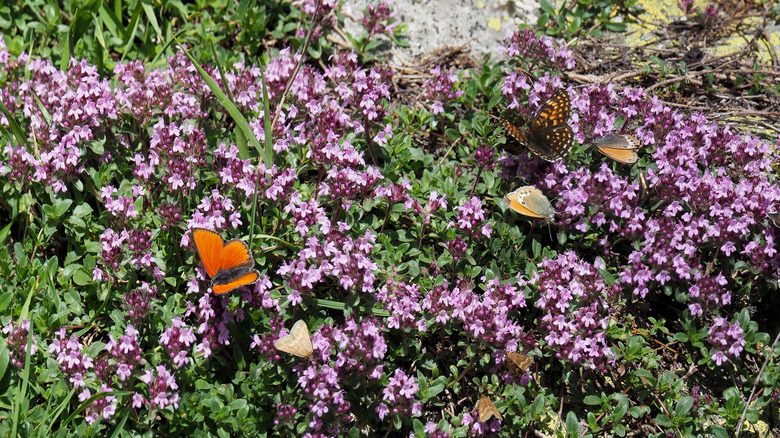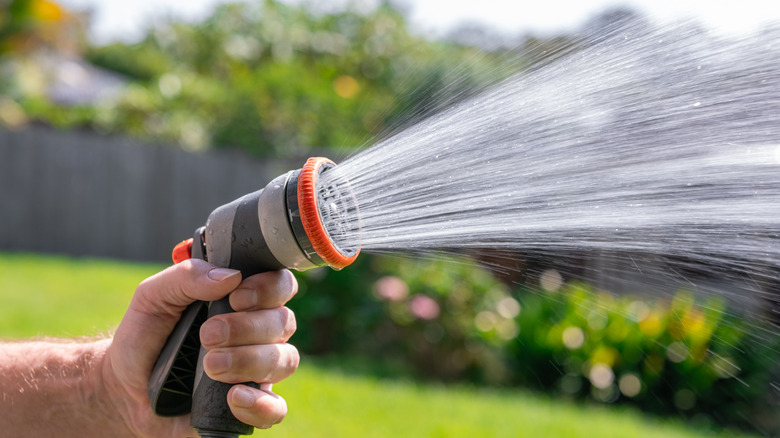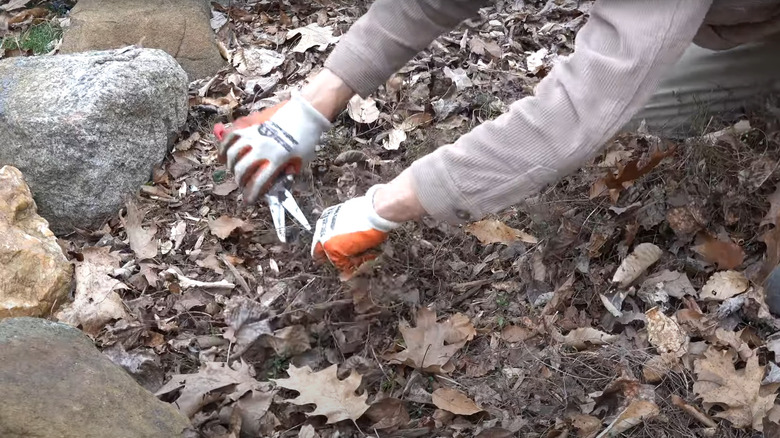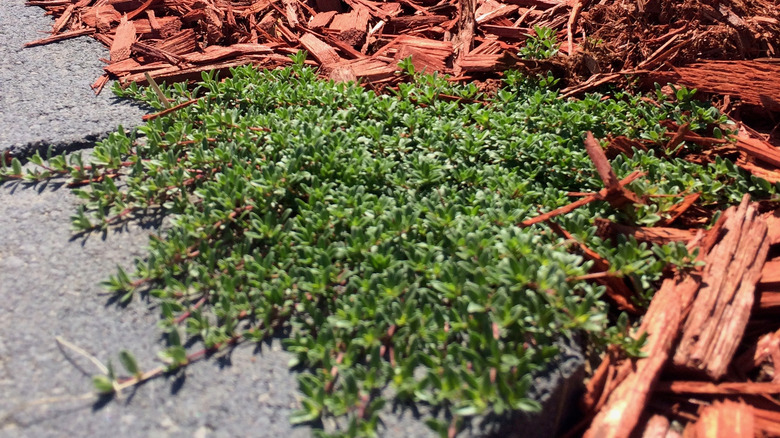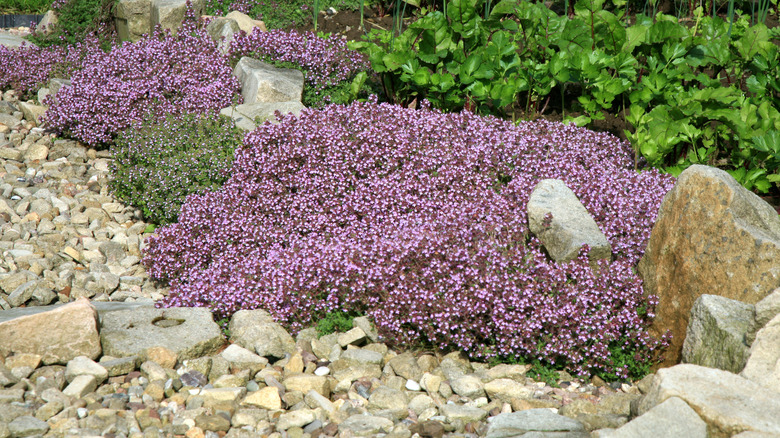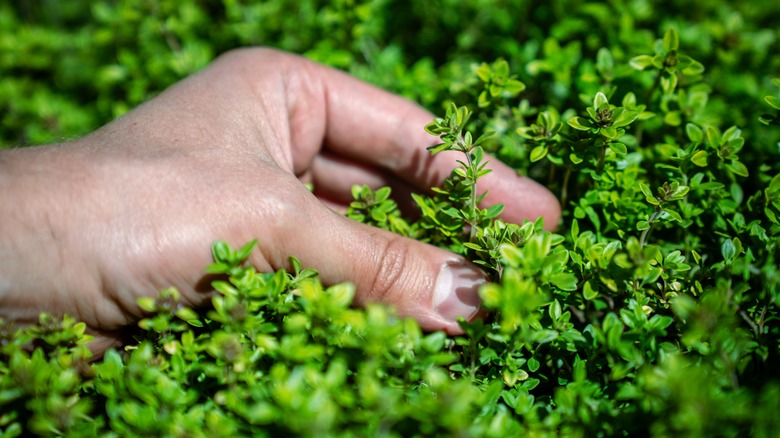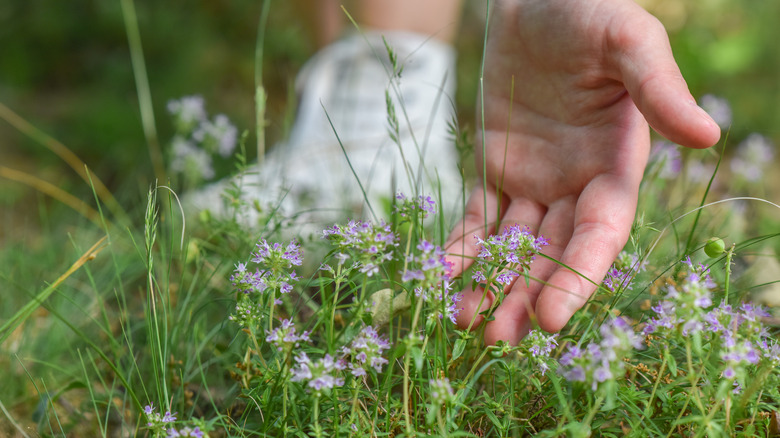Common Mistakes To Avoid When Using Fragrant Creeping Thyme As A Ground Cover
We may receive a commission on purchases made from links.
To us, there's nothing better than the one-two punch creeping thyme offers gardeners. Its wide mat provides seemingly endless blooms of a dusty purple color. But it's more than just a pretty face; creeping thyme's leaves produce the most heavenly fragrance that pollinators and people alike seemingly can't get enough of. Creeping thyme is a fairly tolerant ground cover that's easygoing and can creep along into bare spots and weird crevices, transforming eyesores into stunning floral displays.
Despite its tolerance for some neglect, there's a limit to its ability to thrive. Unfortunately, well-intentioned, but poorly-informed, gardeners can make a few simple mistakes that lay the ground for thyme to fail when all the plant needs is a little tweak in its care. That's why we're breaking down common mistakes gardeners make growing creeping thyme, so that you can know how to set your new ground cover up for success. We'll go over the mistakes we've seen that can have massive implications and show how you can either correct the mistake quickly or avoid it altogether. So break out the hori hori knife (one of the most essential gardening tools) and let's dig in.
Picking the wrong creeping thyme
Like many plants, creeping thyme shares its common name with multiple plants, so it's important to pay attention to the scientific name to ensure you're getting the right creeping thyme for your garden. While both creeping thymes have similar growing conditions, Thymus serpyllum and Thymus praecox will have different results as a dependable ground cover based on a few factors. Namely, T. serpyllum has a larger spread but can only handle light foot traffic, while T. praecox is more compact but can handle moderate foot traffic.
T. serpyllum is definitely more a ground-covering thyme, having a max size of around 4 inches tall and 1 foot wide per plant. There's not much evidence we can point to for why it's not as traffic-tolerant as its cousin, T. praecox. If we had to guess, we might say it's likely that T. praecox's average maximum size, around 6 inches square, means all of its critical functions are tightly compacted and protected. Meanwhile, T. serpyllum's spread makes it have to push nutrients and such out further, making it more vulnerable to damage. So, if you're interested in a ground-covering-ish plant that can handle kiddos and pets trampling on it, T. praecox is your best bet. But if you want a "true" ground cover with a larger spread — and are fine with it being only able to tolerate the occasional "oopsie" trampling, or the addition of a few stepping stones to keep it safe — T. serpyllum is the way to go. Based on these minor-yet-important differences, we want to make it clear that we'll be focusing on T. serpyllum for the rest of the article.
Choosing the wrong location
Creeping thyme is relatively easygoing in its growing conditions, but a few things become dealbreakers for this ground cover. For creeping thyme to thrive, it needs well-draining, neutral or alkaline soil, and full sun. Consistently moist soil or shady spots where excess moisture is trapped will make it susceptible to root rot and ultimately kill it.
Generally speaking, ground covers typically need soil conditions that prevent moisture from getting trapped under their denser, carpet-like structures, which is like putting out a welcome mat for root rot to form. There are ground covers that can handle shade and, consequently, are more moisture-tolerant, but creeping thyme just isn't in that group. That said, "consistently moist" is one of the few soil conditions creeping thyme can't handle; otherwise, it's an incredibly hardy plant that tolerates low-nutrient or rocky, sandy soils without an issue. Therefore, try to place it in a dryer part of your garden. If most of your soil stays a little too moist for creeping thyme, you can either place it in a raised bed or rockery, or grow it as a container plant and incorporate some materials that improve soil drainage and relieve your plants of excess moisture, like LECA balls or terra cotta pot pieces.
Planting at the wrong time
While creeping thyme loves the full sun, it needs time to settle into its new surroundings. Planting a starter creeping thyme plant during the harsh summer months can stress the plant out to the point of failure. Instead, opt for planting it during fall and winter so that it has time to establish itself without needing to deal with the full power of the sun.
But let's say you're impatient or impulse-bought some thyme in June and need to get it into the ground ASAP — does that mean your plant is doomed? Not necessarily. Your best bet for helping your thyme survive the summer is by protecting it from the unrelenting afternoon sun. Install a shade cloth over the planting site for the first summer, like this Sunblock Shade Cloth from Cool Area that filters 55% of the light. Shade cloths are mesh tarps that filter the sun and give plants UV protection, allowing them to get a little bit of light, but not so much that they scorch.
Not preparing the soil ahead of time
Ground covers are hardy plants, but they need a little help from you to get established. Creeping thyme is no different; plopping it in the ground and hoping for the best may give you a 50/50 shot of it thriving. Instead, do a little prep work to the soil ahead of time to ensure your creeping thyme has a happy home that's comfortable and ready to help set it up for success.
Luckily, preparing the ground for a new creeping thyme plant isn't difficult. Start by digging a spot that's around 10 inches deep and a few inches wider than the plant. Next, incorporate some yummy organic matter for the thyme to get nutrients from, like bark or compost. But don't add too much — organic materials can soak up water and creeping thyme needs good drainage, so you may want to mix in some sand or pea gravel to help keep the water moving. After that, your planting area is ready to go, so pop your thyme in and lightly backfill the hole with dirt. Remember not to tamp it down too tightly; compact soil will make it hard to move moisture away from your thyme.
Giving it too much water
Creeping thyme, and most thymus species in general, are drought-tolerant and can handle a bit of neglect here and there. But what thyme can't handle is getting waterlogged, and overwatering your plant can cause root rot to develop, turning your dense ground cover into a mushy mess. Only plant creeping thyme in areas with good drainage or cut back on your watering routine.
But what if you live somewhere that's prone to long rainy seasons — should you write off creeping thyme forever? Not necessarily. Besides incorporating pea gravel or other materials in the thyme's soil to increase drainage, you can also add other ground covers around it that can soak up some of that excess moisture and keep it away from your rot-susceptible thyme. Hardy plumbago (Ceratostigma plumbaginoides), Carolina jessamine (Gelsemium sempervirens), or Irish moss (Sagina subulata) are all ground covers that can tolerate the same soil and sun conditions as T. serpyllum, and will often get thirsty and hate to dry out. Planting a mixture of these could help alleviate some of that excess rainwater and keep your creeping thyme dry and happy.
Not pruning it back
When you think of ground cover plants, you might assume that pruning them back is a bit counterproductive; after all, we want them to spread as much as possible. But creeping thyme can get leggy, producing woody stems that have little growth, looking straight out of a haunted forest. Pruning creeping thyme back will force it to maintain a bushy, dense appearance that covers bare spots better than its woody stems ever could.
This process of pruning back thin, unsightly growth is known as "rejuvenation pruning" and is a great way to force the plant into focusing its energy on new foliage growth instead of long, wiry, creeping stems. Make sure you're using sharp, clean pruning shears to prevent bacteria from invading the mother plant's new wounds, and always maintain and remove rust from garden tools. Luckily, creeping thyme is fairly low maintenance so you shouldn't need to prune it back more than once or twice a season.
Forgetting to add mulch
Mulching is tricky when it comes to ground covers that hate excess moisture, like creeping thyme. However, the benefit mulch provides newly-planted ground covers is worth the balancing act, because it blocks weeds from popping up, disrupting creeping thyme's chance to settle into its new spot. Once your creeping thyme is established, you can cut back on the mulch and let the dense mat do its thing to prevent weeds on its own.
So, what's the problem with mulch? Well, mulches create a thick layer of organic matter on the topsoil, conserving water and acting as a source of plant food as they decay. When added around mature plants that are susceptible to rot, like creeping thyme, things can get dicey, especially if your soil tends towards the moist side. That said, mulching around newly planted creeping thyme is less disastrous as it nourishes and protects the plant from aggressive weeds, acting like a personal bouncer for your baby thyme plant. Using a 2-inch deep layer of mulch around the planting site for the first one to two years will help give your creeping thyme a good head start; just keep an eye on the soil's moisture levels. Mulching with gravel can also work well, as it's less likely to trap moisture, can prevent thyme stems from laying on wet earth, and can help block out weeds.
Planting too closely together
No one likes getting their personal space invaded, including plants. While it might feel helpful to group ground covers together to fill in bare patches, creeping thyme needs space around it. Gaps between your thyme plants will let air circulate and sunshine in, combatting excess moisture and helping to prevent rot.
Being a low-to-the-ground, carpeting plant, creeping thyme is prone to catching moisture-related diseases and fungal infections, like powdery mildew and root rot. Consequently, the more clustered together multiple plants are, the higher the likelihood one can develop something nasty and spread it to the rest of the colony, which just adds to the headache of trying to treat it. It's like whack-a-mole, mildew edition. Instead, give your plants room to stretch out and grow without having to encroach into any neighboring plant's spot. Since T. serpyllum has an average maximum spread of around a foot, try to give each plant a buffer space of 6 to 8 inches on every side.
Not swapping out old plants
Unfortunately, plants aren't immortal and will eventually die off. One usually hopes that by the time a plant is ready to go to the compost heap in the sky, it's propagated itself in some way that keeps your garden covered with new baby replacements. Regardless, creeping thyme typically has around a three-year lifespan and should be swapped out for a new plant once it's stopped growing and its stems have become more woody than foliage-dense.
But, how can you tell if the plant is dead or just getting leggy? The easiest way is to perform what's known as the "scratch test." Gently use a knife or fingernail to scrape away the bark on a thyme stem that's grown a little away from the center plant hub — notice the texture of the bark and the color of the "flesh." Alive, healthy plants will have green tissue and smooth, firm bark, while dead plants will have brown tissue and flaky, peeling bark. If you've found brown tips, scrape a little bark away from closer to the center; if it's green towards the root ball then it's still alive and just needs the dead tips pruned off. If it's nothing but brown, though, it's time for a creeping thyme funeral.
Expecting immediate results
We know, waiting for that dream garden to grow is really hard, but helicopter parenting newly-planted creeping thyme can do more harm than good while the plants are settling into their new home. Ground covers can take up to two years to fully establish themselves, so you have to be patient and let your creeping thyme find its groove, as difficult as that may be. You might be able to get away with waiting only a year before the thyme matures, but the more you fuss with it, the less likely it will be able to thrive.
As with all things gardening, though, there's a balance you'll need to navigate, because too much neglect can be a thyme killer, too. Starter plants are typically the most vulnerable, just like human kiddos, and will need the most care. Remember the dealbreakers for baby creeping thyme plants while caring for it, so that you find that good balance: well-draining soil, a little mulch for weed prevention and food, not too much water, and protection from the harsh afternoon sun while it's growing. Look for signs that your ground cover is getting too much water (here's how to save an overwatered plant if this has happened), but otherwise, backing off and letting Mother Nature do its thing will ensure your creeping thyme becomes a lush ground cover in no time.
